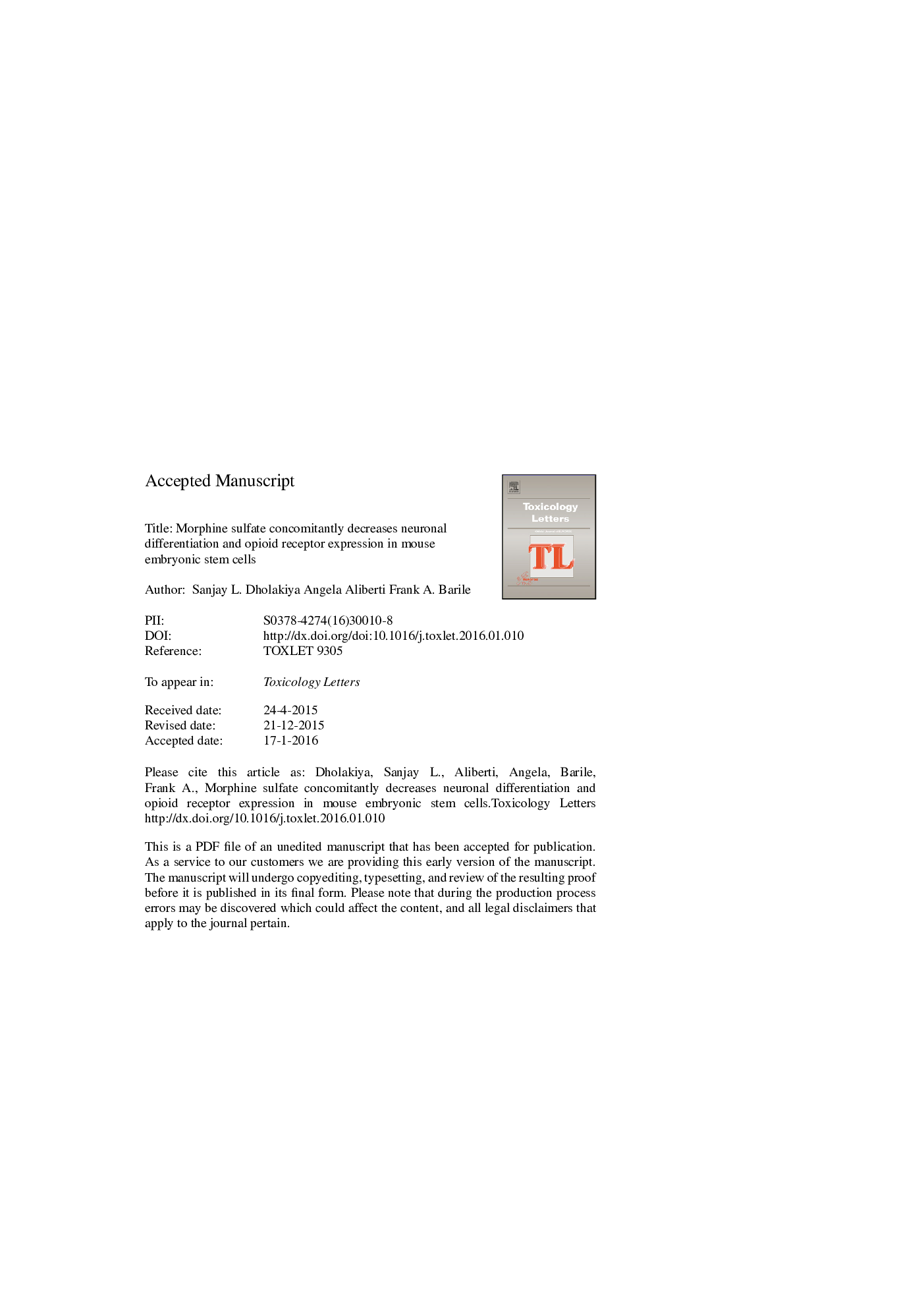| کد مقاله | کد نشریه | سال انتشار | مقاله انگلیسی | نسخه تمام متن |
|---|---|---|---|---|
| 5859819 | 1562625 | 2016 | 34 صفحه PDF | دانلود رایگان |
عنوان انگلیسی مقاله ISI
Morphine sulfate concomitantly decreases neuronal differentiation and opioid receptor expression in mouse embryonic stem cells
دانلود مقاله + سفارش ترجمه
دانلود مقاله ISI انگلیسی
رایگان برای ایرانیان
کلمات کلیدی
EGFDMEMITSMORGFAPbFGFLIFmES cellsOct4δ-Opioid receptor - δ-گیرنده اپیوئیدμ-Opioid receptor - μ-گیرنده اپیوئیدinsulin-transferrin-selenium - انسولین انتقال دهنده سلنیومNeuronal differentiation - تمایز نورونDOR - دردMouse embryonic stem cells - سلول های بنیادی جنینی موشneuronal progenitor cells - سلولهای پیش ساز Neuronalepidermal growth factor - عامل رشد اپیدرمیleukemia inhibitory factor - عامل مهارکننده لوکمیbasic fibroblast growth factor - فاکتور رشد فیبروبلاست پایهoctamer-binding transcription factor 4 - فاکتور رونویسی اتصال دهنده octamer 4Dulbecco’s modified eagle’s medium - محیط عقاب اصلاح شده Dulbeccomorphine - مورفینmorphine sulfate - مورفین سولفاتKOR - وقتیMicrotubule associated protein 2 - پروتئین مرتبط با میکروتوبول 2κ-opioid receptor - گیرنده κ-اپوئیدOpioid receptors - گیرنده های اپیدمی
موضوعات مرتبط
علوم زیستی و بیوفناوری
علوم محیط زیست
بهداشت، سم شناسی و جهش زایی
پیش نمایش صفحه اول مقاله

چکیده انگلیسی
Opioids have been shown to affect prenatal and postnatal neural development in mammals. The present study investigates the impact of morphine sulfate (MS) treatment on neuronal differentiation as well as μ-opioid receptor (MOR) expression in mouse embryonic stem (mES) cells. Stem cells were manipulated in culture to differentiate in 3 sequential stages: Stage 1, cell transformation to embryoid bodies (EB); Stage 2, EB cell differentiation to neural progenitor (NP) cells; and, Stage 3, NP cell differentiation to neurons/astrocytes co-cultured cells. Using RT-PCR and flow cytometry analyses, cell types were confirmed by monitoring expression of Oct4, nestin, microtubule-associated protein 2 (mtap-2), and glial fibrillary acidic protein (GFAP) as cell-specific markers for stem cells, NP cells, neurons, and astrocytes, respectively. Similarly, gene expression for MOR, κ-opioid receptor (KOR), and δ-opioid receptor (DOR) was confirmed in each cell type. In order to investigate the effects of MS on differentiation, cells were treated with MS (1, 10, 100 μM) at either early (Stage 1) or late (Stage 3) stage of cellular differentiation. At Stage 1 exposure, MOR gene expression and neuroectoderm specific marker expression of nestin were down-regulated in both EB and NP cells. In addition, the opioid down-regulated GFAP in differentiated neurons/astrocytes co-cultured cells. Late stage treatment with MS resulted in a down-regulation of mtap-2 and GFAP in differentiated neurons/astrocytes co-cultured cells. Moreover, late stage treatment with MS and naltrexone inhibited the effect of MS on neuronal differentiation, suggesting that MS treatment interferes with differentiation via MOR activation. Together, the results show that MS exposure at early and late stage of cellular differentiation significantly decreases genotype and phenotype in differentiated neuronal cells. The results of this study have implications regarding the potential effect of opiates on fetal brain development.
ناشر
Database: Elsevier - ScienceDirect (ساینس دایرکت)
Journal: Toxicology Letters - Volume 247, 15 April 2016, Pages 45-55
Journal: Toxicology Letters - Volume 247, 15 April 2016, Pages 45-55
نویسندگان
Sanjay L. Dholakiya, Angela Aliberti, Frank A. Barile,